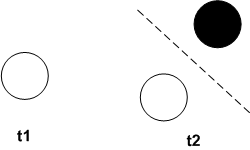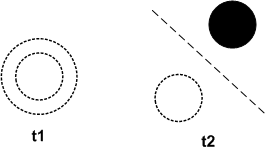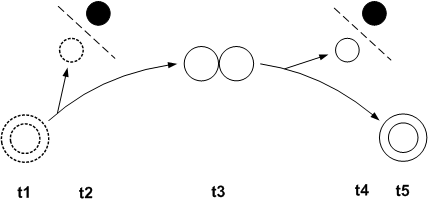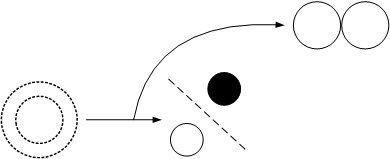INSTITUTIONALISED VIOLENCE AND SPIRITUALITY
1986; presented at an AHPP Conference on Violence and Spirituality.
At first sight there is sheer incongruity here. It would seem far easier to talk about either the one or the other. Better not to confuse things by trying to bring them into the same discourse.
Institutionalised violence
I suggest the following definition of violence:
the infringement of someone’s boundaries – bodily, emotional, intellectual or spiritual –
- by invasion (e.g. hitting)
- by deprivation (e.g. starving)
There is institutionalised violence when this infringement occurs not through the actions or negligence of individuals (whether acting on their own or in some organisation) but as a result of social and/or economic and/or legal structures
e.g.
- apartheid
- slavery
- poverty in the midst of potential plenty.
In such cases straightforward violence is always on hand as a threat to any who may attempt to circumvent or destroy the structures.
Third World poverty and starvation is, of course, complex. But economic violence resulting from the servicing of loans is a crucial factor. Thus Salim Salim, Deputy Prime Minister of Tanzania, wrote in the Guardian of 16.5.86.:
“The staggering debt of developing nations has had a crippling effect of their economic growth. The current debt, at nearly $900 billion, amounts to more than one-third of the Third World’s gross domestic product. For a number of countries, the ratio of debt repayment to national export earnings now amounts to one-half, two-thirds and in some cases more than total exports.”
In fact the term “institutionalised violence” is not much used. It tends to be brought in during arguments about whether it is justified to use straightforward violence in resisting oppression. X says “It is wrong to use violence to fight oppression”. Y replies: “But you talk as though violence can be included or excluded at will. There is already colossal violence – institutionalised violence – being perpetrated. Where peaceful protest has failed, you have to choose whether to adopt a policy of minimal violence to remove the oppression, or one of condoning the massive institutionalised violence already taking place”.
Spirituality
I suggest the following definition of spirituality:
the exploration of the areas of experience that are beyond the duality of ourselves and the environment or ourselves and other people – i.e. the areas where subject and object merge, and boundaries dissolve or are found to be illusory. (Cf. the often quoted Sanskrit formula TAT TVAM ASI, “that art thou”.)
Linking the two concepts
By means of these two definitions, our two terms have come a little closer together. Both concern boundaries. However, the boundaries are viewed from very different angles. Institutionalised violence infringes boundaries that are taken to be genuine and to be deserving of respect. Spirituality concerns the dissolution of boundaries, or their illusoriness. We can only hold them together by appealing to different levels of being or consciousness. (By so doing we are of course asserting a new boundary between these two levels themselves. Is that boundary to be respected, or is it dissoluble and illusory? I leave that question on one side, as we are in danger of starting an infinite regress.)
There are many ways of mapping these things – for instance Assagioli’s “egg” diagram (1965) or Ken Wilber’s Great Chain of Being (1980, 1983a). However, the trouble begins when we realise that we are all located on several points on any map. We may be meditating regularly and finding something of non-dual awareness, yet at the same time we are involved in institutionalised violence as either victims or beneficiaries, or indeed as both. For we are within an economy where the gap between rich and poor is increasing, where millions are starving, and where the rich are rich by making the poor poor. World society is divided into classes, the basis of the division being the extraction of surplus wealth (i.e. what is created over and above what is needed for the maintenance of those creating it) by one class from another. Non-dual awareness of a reality riven with competitive dualism: is this “unity consciousness” (Wilber) or false consciousness (Marx)?
There is clearly a tension between these two levels. Maybe if we were spiritual athletes, and had reached nirvana, Atman, the unitive way or whatever, the tension would be transcended in some way. Similarly, if there were a fully successful socialist revolution, so that class society were replaced by a truly communal way of living, there would be no such tension between social and spiritual reality. Short of that, we need some way of conceptualising what is going on, in order to make progress towards these ideals.
Defence by projection
The concept I want to investigate is that of the paranoid-schizoid defence: dealing with pain and anguish by denying these bad feelings in oneself or in part of oneself, and projecting them on to another, to others, or to another part of oneself. Thus a split occurs between an internal good and an external bad, and a measure of safety is obtained within the internal sector. “I’m OK, you’re not OK”. (The alternative split, making the internal good and the external bad, I leave on one side.)
Well-known examples are the retreat into the head, where the rest of the body is made to contain the badness; the use of one member of a family as the bad one – the black sheep – to maintain the innocence of the others; the literal use of a scapegoat by tribes wishing to get rid of feelings of guilt and badness; not to mention metaphorical scapegoats of many other kinds.
The process can be represented thus, comparing two times t1 and t2:

Let us now look at the matter more closely in the life of the individual and in that of the evolving human race.
Projection within the individual
In the individual case, we begin with the foetus in a state of awareness before duality has clearly arisen. In Gestalt terms there is not contact between the unborn child and the mother so much as confluence: foreground and background coalesce, subject and object merge into a single experience. There is thus a non-dual awareness of a sort, which can be represented thus:

Later (though this may still be before birth) the difference between “me” and “not-me” begins to dawn. Mother is experienced as alternately benign and fulfilling on the one hand, and cruel and refusing on the other. So the infant resorts to the defensive split in order to cope with this chaotic experience. The Kleinian view is that this occurs after birth. There is also the view taken by Frank Lake and David Wasdell that the foetus may experience cataclysmic events that also urgently require the defensive split. In either case we can represent the case thus:

At t2 the rejected person or part-of-person is “beyond the pale”.
However, unless the damage has been too severe, some kind of development towards maturity occurs, where contact between two persons regarded as distinct is possible:
![]()
Nevertheless, paranoid reactions are still likely whenever the buried memory of infant struggles is restimulated.
Further, the given the opportunity, the person may have spiritual experiences where non-dual awareness or confluence is again available. Ken Wilber (1983b) is most insistent that this has nothing in common with the infant’s experience of non-duality, and he calls any attempt to reduce the one to the other as “the pre-trans fallacy” – i.e. the fallacy of confusing pre-personal non-duality with transpersonal non-duality. I find it helpful to make a slightly less categorical distinction, and to see the later mystical experience as based, at least in part, on the infantile one (see Collingwood 1984a), but exceeding it vastly by dint of the greater maturity of the person concerned. So it could be represented by a symbol suggesting a clear, as opposed to a hazy, non-duality:

Thus we can plot the human trajectory thus (clearly this diagram owes much to Ken Wilber’s map):

Here t2 is an infant’s use of the projective defence, t4 an adult’s. I have put t4 near to t5 to bring out the possibility that adult splitting can occur not only in interpersonal situations, but also as one approaches the transpersonal. For here one can begin to despise the body, and regard it as a tomb: SWMA SHMA. One way of doing this is to overvalue the feelings that can accompany spiritual insight, so as to attain to a kind of pseudo-mysticism (see Rowan 1984). This whole splitting tendency could be called an ungrounded spirituality: there is an urge to deny and/or decry the fact that we are grounded in a material body, and that our body is grounded on the surface of a material planet with which we are engaged in a continual exchange of matter such as air and food. Once again it is a defence against confusion, a short cut to clarity and peace, when there is in fact a tough road ahead leading only slowly to wholeness or holiness.
Projection within the evolving human race
Today, in our culture we each normally have a sense of being a separate person: an ego. But we can surmise that this was not always so. Wilber (1983a) has brilliantly brought together the evidence that points to a growth of consciousness from something dim and deeply tribal rather than individual, with only the simplest language, at the hunting and gathering stage. With more settled farming (roughly 8-6000 BC in SW Asia, the Neolithic age) and a language possessing tenses, a more advanced form of consciousness emerged, which he calls “myth-membership”. Later, from about 2500 onwards, began the “egoic” consciousness of which we are seeing the later phases, where the controlling self (ego) is glorified to the exclusion of either the bodily or the emotional processes or both; fragmentation of the person has become the norm.
A crucial point in this development was when a surplus product was first obtained: i.e. people could produce more than they could immediately consume. Food etc. could be stored for the future. This allowed the emergence of a special class of people, e.g. priests, educators, who did not take part in actual production, although of course they consumed part of what was produced. The division of labour had begun, and people started to amass wealth and use others (often slaves captured in war) to work on it. It seems that private property was part of being a person: women and slaves were not owners but owned (See Wilber, 1983a pp.273-4). They were non-persons, and they were the means to a property-owning man’s personhood, but also a threat to it; slaves had to be kept from rebelling. So once again we find a paranoid picture, the good wealthy man and the despised slave, a picture alive in ancient Greek times (aristocracy means “rule by the best”) and in 18-19th century slavery times, and in Hitlerian anti-semitic times, and in contemporary racist times. Throughout this period we have had patriarchy, the systematic disempowerment of women. Thus we exploit a group, treat them as less than human, and then cope with the confusion and embarrassment by the comforting rationalisation that they are not so human as ourselves, so it does not matter.
Towards the healing of the splits

Thus we have fragmented people in a fragmented society. In spite of all the tendencies towards a “global village”, politics is almost entirely dominated by paranoid assumptions: we have to have an enemy, without or within. Even spirituality, as we have seen, can be conscripted to play a role in the splitting game.
To heal all these splits is a gigantic task, requiring work on all three fronts, therapeutic, political and spiritual. The psycho-therapeutic way is often seen as “reowning the projections”, and it is worth asking whether this procedure can throw light on the political and spiritual agenda too.
Here I would like to make us of David Boadella’s work on the embryonic layers (1976). I have explored some of the social and economic ramifications of this approach elsewhere (Collingwood 1986). Boadella takes the three layers which successively are formed in the embryo – ectoderm, endoderm and mesoderm – and which give rise to respectively (1) the skin and the nervous system; (2) the alimentary and respiratory systems; and (3) the skeletal, cardio-vascular and muscular systems. He goes on to link these to the therapeutic tasks of, again respectively, facing, centering and grounding. Elsewhere1 he considers the possibility of the aura as existing before the formation of the foetus and as guiding its development. If it is correct to connect the aura with spiritual energy and the seventh chakra, then it is reasonable to speak of a fourth element of balanced living, beyond that of facing, which could be called opening.
This understanding of the human organism can be usefully linked to the Gestalt approach. Where grounding is poor, the energy does not go out into the environment in expressive or creative activity, but is turned in on itself in retroflection. Where centering is inadequate, the material ingested is not assimilated but lies around in a raw state, asking to be vomited – introjection. Where facing is incomplete, what is disowned internally is imagined externally, so that the other is not really seen – projection. What of opening? It would seem that the term confluence neatly describes the evaporation of boundaries that constitutes spiritual experience as here defined. Accordingly the cases considered above, where spiritual experience is received in a way that belittles what is seen as somehow inferior to the spiritual, can be regarded as due to a confluence that is only partial. Not that we need fall into the trap of belittling partial confluence itself: it is merely a matter of seeing the danger of moving from a partial confluence – what is, after all, the level of spiritual experience many people are likely to reach – to a belittling, projective, attitude. (Fritz Perls tended to see confluence as having only a pejorative meaning, so although I can recall no place where he speaks of mystical experience as confluence, it is no surprise that he regarded Zen meditation as an attempt to achieve catatonia – see, for instance, the Introduction to Perls, 1969.) For my own attempt to relate the categories of Gestalt Therapy to character structure, see Collingwood 1984b.
| Gestalt terms for typical failure: | My and D.B.'s terms for success | Marxist terms | |
|---|---|---|---|
| aura | “partial confluence” | opening | (nil) |
| ectoderm | projection | facing | ideology |
| endoderm | introjection | centering | social relations of production |
| mesoderm | retroflection | grounding | material forces of production |
The grounding, centering, facing distinction has clear parallels with Marx’s picture of society as having three basic layers. For grounding corresponds to the interaction with the environment to produce goods for consumption (“the material forces of production”); centering to the ways in which we relate to one another as employers, workers and so on (“the social relations of production”); facing to the communications that are needed to justify the status quo, i.e. beliefs and the institutions that promulgate them (“the ideological superstructure”). The correspondence is not exact, of course; as always in this investigation, we are teasing out structures, not identifying sharply separate entities. In particular, ideology in Marxist theory is looked in pejoratively as a form of communication designed to conceal reality, a kind of disinformation. In a fully human, post-revolutionary, society, it would be replaced by clear communication of human needs and of the ways of meeting them. What then of “opening”? Surely it points to the question as to whether it is possible to have a future society where the otherness of others is transcended, and a social correlate of individual mysticism is available to be enjoyed by all. This is of course to go well beyond the territory charted by Marx and Engels and by most Marxists ever since. The goal of treating persons as persons, not as things, has seemed distant enough. It is still very far away. Yet the current interest in spirituality, in so far as it is not coloured by the projective defence discussed here, is vastly different from the religion castigated by Marx, and deserves a place on the map of the socialist project if the deepest meaning of socialism is to be allowed to unfold.
Following the Marxist “guiding thread”
Thus we are looking at the task of a double healing: of the individual and of society. One way of approaching it is to start with the ways in which the layers (embryonic, and social) are related to each; other. Marx (1859) found a “guiding thread” for his researches in the assumption that the lower layers have a determinative influence on the higher ones. This is not to deny that is also influence in the opposite direction; Marx was not a “mechanistic” materialist, nor a “technological” one (i.e. he did not hold a position that reduced all activity to the kind of determinism that held sway in physics – according to his view of physics – nor one that ascribed all human progress simply to changes in technology). But what is being suggested is that how we are grounded (as individuals) and interacting with the environment (as a productive society) sets limits to what is currently possible so far as centering (individuals) and intergroup relationships (society) are concerned. Again, how we are centred (individuals) and related groupwise (society) sets limits to what is currently possible as far as facing (individuals) and making shared sense of our needs and their fulfilment (society) are concerned. Finally, how we are facing (individuals) and communicating (society) sets limits to what is currently possible as far as individual and corporate spirituality (if you like, the transpersonal and the trans-social) are concerned.
It is difficult for many today in the humanistic psychology movement to take seriously Marx’s dictum that
“It is not the consciousness of men which determines their existence, but on the contrary, their social existence determines their consciousness” (1859)
even if we take “determines” in the sense above defined (i.e. “sets limits to the development of”). And clearly it is that view that underlies the structure of limiting factors outlined above. Wilber (1983) is scathing in his rejection of such a position, which he regards as crudely reductionist. But it is easy to hear Marx, in spite of his own protestations to the contrary, as a deterministic materialist; less easy to tease out a more nuanced position that squares better with his general stance. One can avoid the absurdity of saying that matter creates spirit while still recognising that matter has a limiting function. Then one can retain a respect for the material world, the very respect that is denied by taking the paranoid defensive position discussed above: SWMA SHMA. Moreover, modern studies of matter, revealing it as energy rather than inert “stuff”, make it easier to see some continuity between different kinds, or levels, of energy.
Conclusions
What practical conclusions follow from taking this view of the layers of personal and social being – conclusions that may help us to deal with the paranoid defences that we have been noticing?
First: because the lower levels have a limiting function vis-a-vis the higher ones, they need to be respected and explored. It is like the seaman’s respect for his “ground” – the sea. Greater understanding of the limits allows new developments within them. Also there may be change at lower levels, allowing new possibilities to emerge. Thus with regard to grounding, as individuals grow, they become more mobile on the ground and can do more things; as societies develop their technologies for interacting with the environment, they find new ways of relating with one another to be possible. A healthy respect for grounding, individual and social, is the opposite of paranoid scapegoating of it; it must be the goal of the therapeutic changes needed by the individual and of the political changes needed by the society.
Second; As regards the individual, with particular reference to spirituality: spirituality needs to be approached not as an escape from the body or from society, but as a discovery of a further dimension of our total experience – a discovery of the “energy-body”, the “chi-body” or the “spiritual body”. The mystic who has tamed the ox in the Ten Zen Pictures needs to return to the market-place to share in taking care of other people’s bodily as well as spiritual needs. That is why he is carrying a basket of fish. We need approaches which stress the ordinariness of enlightenment.
Third: As regards society, with particular reference to institutionalised violence, we need to examine the highly social (co-operative) nature of advanced production, and to see how it provides much wider possibilities than are taken up by the exploitative mode. There is the technical possibility of a decent living for all on the planet, and we need to find social relationships that will be appropriate. Then the inequality of opportunity that is at the core of institutionalised violence will be overcome: at last there will be the possibility of what might be called institutionalised love – better known as socialism.
1 I can’t find a reference to the aura in this connection. But in “The Womb, The Tomb & The Spirit, Pt I” (Energy & Character August 1982) he writes of Hernani Andrade’s theory of “the biological organising matrix”, which suggests that the body tissues don’t create a “bio-magnetic field” but have their organisation formed by it.
Assagioli, R, Psychosynthesis, Turnstone, Wellingborough, 1965.
Boadella, D, Organ-systems & Life-styles: Pt I, in Energy & Character,
September 1976 (reprinted as Dynamic Morphology in Embryology
& Therapy, Abbotsbury, n.d.).
The Womb, The Tomb & The Spirit, in Energy & Character, August 1982
Collingwood, N, Ecstasy & Infancy in Self & Society, May-June 1984(a).
Towards Gestalt Politics,
Connect Paper No 5, 1984 (b).
Embryonic
Layers and Social Oppression, in Energy & Character, August
1986.
Marx, K, Preface to a Contribution to the Critique of Political Economy,
1859, many times reprinted, e.g. in Marx & Engels, Selected Works, Lawrence & Wishart,
London, 1968.
Perls, F, Gestalt Therapy Verbatim, Bantam, N.Y., 1969.
Rowan, J, review of Piero Ferrucci’s What We May Be in Self & Society
March-April 1984.
Wilber, K, The Atman Project, Quest, London, 1980.
Up From Eden, RKP, London, 1983 (a).
Eye To Eye, Anchor, N.Y., 1983 (b).
Some other books that have helped me to get where I am and are relevant to the general line of this paper:
Boadella, D, Wilhelm Reich: The Evolution of His Thought, recently
republished
Happold, F C, Mysticism: a Study & an Anthology, Penguin, London, 1963.
Harman, C, Women’s Liberation & Revolutionary Socialism, in International
Socialism, 23 Spring 1984.
Miller, A, For Your Own Good: Hidden Cruelty in Child-rearing and the Roots
of Violence, trans Hannum H & H, Faber, London, 1983.
Ollman, B, Social & Sexual Revolution, Pluto, London, 1979.
Reich, W, The Mass Psychology of Fascism, trans Carfagno, V R, Farrar
ScC,N.Y., 1970.
Rowe, D, Living With The Bomb, RKP, London, 1985.
Watts, A, Psychotherapy East & West, Ballantine, N.Y., 1961.
Wilber, K, The Spectrum of Consciousness, Quest, N.Y., 1977.
Finally the Trotsky quote, for which I have lost the reference, is: Socialism,
if it is worthy of the name, means human relations without greed; friendship without
envy and intrigue; love without base calculation
.